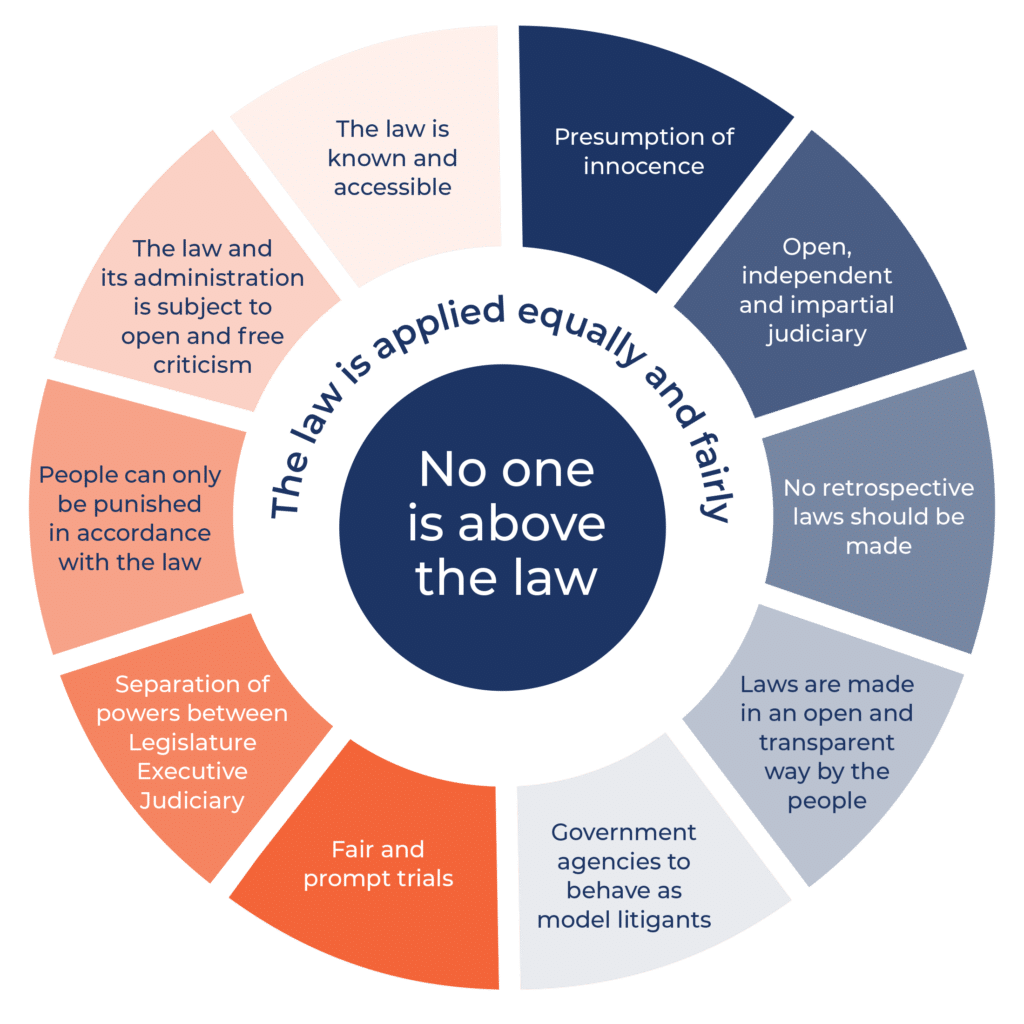At the recent “Open and Shut” workshop held jointly by the Rule of Law Institute of Australia(RoLIA) and the Australian Centre for Independent Journalism at UTS, participants heard from a range of experts in law and the media about the tension between the principle of open justice and the increasing numbers of suppression orders being made by judges to prevent publication of names or evidence given.
The keynote speaker, the Hon Philip Cummins AM, delivered a paper about the importance of open justice in the court system, below is the paper he delivered at the workshop.
OPEN COURTS: WHO GUARDS THE GUARDIANS?
A PAPER delivered by the Hon. P.D. Cummins at JUSTICE OPEN AND SHUT: Suppression Orders and Open Justice in Australia and the United Kingdom
A SEMINAR conducted by the Rule of Law Institute of Australia and the Australian Centre for Independent Journalism
4 June 2014 – Sydney
About the Author

Download the full PDF of the paper
I
Kafka ironically put it thus:
K. might care to remember that the proceedings were not public; they could be opened to the public if the Court thought this was necessary, but the Law did not insist on publicity.[1]
In contrast, the courts have firmly propounded the principle, and value, of open justice. Lord Atkinson stated:
The hearing of a case in public may be, and often is, no doubt, painful, humiliating, or deterrent both to parties and witnesses, and in many cases, especially those of a criminal nature, the details may be so indecent as to tend to injure public morals, but all this is tolerated and endured, because it is felt that in public trial is to found, on the whole, the best security for the pure, impartial and efficient administration of justice, the best means for winning public confidence and respect.[2]
In like vein, President Kirby (as he then was) stated:
It has often been acknowledged that an unfortunate incident of the open administration of justice is that embarrassing, damaging and even dangerous facts occasionally come to light. Such considerations have never been regarded as a reason for the closure of courts, or the issue of suppression orders in their various alternative forms…[3]
Justice Gibbs (as he then was) stated:
This rule has the virtue that the proceedings of every court are fully exposed to public and professional scrutiny and criticism, without which abuses may flourish undetected. Further, the public administration of justice tends to maintain confidence in the integrity and independence of the courts. The fact that courts of law are held openly and not in secret is an essential aspect of their character. It distinguishes their activities from those of administrative tribunals, for ‘publicity is the authentic hallmark of judicial as distinct from administrative procedure’.[4]
Burger CJ drew the connection between openness and the media:
Instead of acquiring information about trials by firsthand observation or by word of mouth from those who attended, people now acquire it chiefly through the print and electronic media. In a sense this validates the media claim of functioning as surrogates for the public.[5]
The nineteenth century legal philosopher, Jeremy Bentham, in a passage written on our hearts, stated:
Publicity is the very soul of justice… it keeps the judge himself, while trying, under trial.[6]
It can be seen from the authorities that open justice is an essential characteristic of our court system, that it not only informs the community but importantly tends to the pure administration of justice, and that embarrassment is no justification for courts not being open. We know from long experience that there are frequent pressures for courts to function in private. Sometimes that pressure is from high motives, sometimes base. But it is ever present and must be resisted.
II
What, however, of pressure from within?
Whilst the courts, rightly, proclaim and are committed to the principle of open justice, embedded in the law is the seed of containment. Lord Woolf MR in R v Legal Aid Board, ex parte Kaim Todner stated:
The need to be vigilant arises from the natural tendency for the general principle to be eroded and for exceptions to grow by accretion as the exceptions are applied by analogy to existing cases.[7]
This was put more directly by Lord Shaw of Dunfermline in Scott v Scott:
There is no greater danger of usurpation than that which proceeds little by little, under cover of rules of procedure, and at the instance of judges themselves.[8]
We need to be astute to this inherent tendency of judicial method.
Plainly, there will be instances wherein courts cannot responsibly be open or fully open. The physical safety of witnesses, interconnected criminal trials, family law hearings, sexual assault evidence identifying victims, trials involving children, some elements in terrorism trials involving national security – these are well-known and legitimate exceptions, many secured by legislation. However, academic and other review of suppression orders made by courts reveals that the scope and number of such orders far overshoots those exceptions. In 2006 Professor Andrew Kenyon wrote of the matter in “Not seeing justice done: suppression orders in Australian law and practice.”[9] Last year was published a timely review, co-authored by one of today’s presenters, Jason Boland, titled “An empirical analysis of suppression orders in the Victorian Courts: 2008-12.”[10] During today’s Seminar, further material will be presented establishing the extent, in content and in number, of such orders.
Many orders are properly made; others not so. It is clear that some orders are wrongly made, because legislation already prohibits publication,[11] or because the principle of sub judice already governs the situation. It would be seriously retrograde if that powerful principle came to be supplanted by suppression orders. On other occasions, therapeutic, prophylactic or prudential grounds falling short of necessity are the occasion for suppression orders. And on other occasions, inadequate understanding of the integrity and discipline of the jury system founds suppression orders. Long experience of the jury system shows that juries, when given proper and full instruction by judges, are well able to put aside extrinsic material and to act solely on evidence led in court.
In law, the touchstone of issuance of suppression orders is, and must be, necessity. Nothing less. We must be astute to the tendency of multiple issuance of suppression orders eroding that critical test. We must resist a tendency to resile from necessity to convenience. Suppression orders should only be a last resort and should never be a first resort.
III
Recent years have witnessed the introduction of Open Courts Acts.[12] These are a commendable legislative intervention. These Acts rehearse the basal principle at common law, and provide clear process. They characteristically state a presumption in favour of disclosure. They provide locus for the media. They provide that orders should operate for no longer than is reasonably necessary, and provide temporal limitation of orders. (Even here, we need to be astute that the outer limit of 5 years does not become the default limit by court order.) Importantly, they provide clear provisions that an order is limited to achieving the purpose for which it is made, does not comprehend any more information than is necessary for that purpose, and that it is readily apparent from the terms of the order what information is subject to that order. (Again, precise drafting of orders is essential to fulfilment of that last provision.)
However, it is necessary to consider the legislative grounds for making a suppression order. The Model Court Suppression and Non-publication Orders Bill 2010 (Standing Committee of Attorneys-General) provided:
8. Grounds for making an order
(1) A court may make a suppression order or non-publication order on one or more of the following grounds:
(a) the order is necessary to prevent prejudice to the proper administration of justice,
(b) the order is necessary to prevent prejudice to the interests of the Commonwealth or a State or Territory in relation to national or international security,
(c) the order is necessary to protect the safety of any person,
(d) the order is necessary to avoid causing undue distress or embarrassment to a party to or witness in criminal proceedings involving an offence of a sexual nature (including an act of indecency),
(e) it is otherwise necessary in the public interest for the order to be made and that public interest significantly outweighs the public interest in open justice.
(2) A suppression order or non-publication order must specify the ground or grounds on which the order is made.
Grounds (a) – (d) substantially reflect the pre-existing law. Ground (e) is a change. There are two observations I would make about the model.
As to ground (d), I see no justification for providing a defendant in sexual offence matters the ground for application for a suppression order unless the identity of the victim thereby would be revealed. The protection which legitimately shields victims and witnesses in sexual offences, and children generally, does not apply to adult defendants. Commendably, the Victorian Open Courts Act 2013 by section 18(1)(d) protects ‘complainants’ and ‘witnesses’,[13] departing in this respect from the language of the model legislation, which protects ‘parties’. Likewise sub-s 1(e) of the Victorian Act protects children. That is sufficient protection. It should not extend to defendants.[14]
As to ground (e), I consider that this provision is misconceived and is contrary to the purpose and rationale of the open courts principle. Public interest is a Janus-like criterion, malleable and capable of significant judicial extension contrary to courts being open. It matters little that there is a weighing or balancing requirement as provided by the model provision. The potential lurking in the model provision can be seen in the reasoning in Welker & ors v Rinehart, in which his Honour was considering section 8(1)(e) of the Court Suppression and Non-publication Orders Act 2010 (NSW) and which provided in similar terms to the model s 8(1)(e):
“While the Court is commanded, by s 6, to take into account that a primary objective of the administration of justice is to safeguard the public interest in open justice, the weight to be given to the public interest is liable to vary, depending on the nature and stage of, and issues in, the proceedings. Without seeking to be prescriptive, it will often be relevant to consider whether the proceedings are criminal (in which typically the interest in open justice will be greater) or civil; whether they involve questions of public or private law; and whether they involve disputes that impact on the public or only the parties…
…
These practices reflect an acceptance that the public interest in open justice may attract less weight where private issues and interests are concerned. That is not to say that open justice does not remain, as s 6 stipulates, a primary objective of the administration of justice. But in such cases, in the balancing exercise required by s 8(1)(e), it may be somewhat less weighty.
In the present case, to the extent that there remains a dispute at all, this is and always was a family dispute, about interests in and governance of a family trust. The outcome is of practical interest only to the parties and their privies. No questions of public significance or importance appear to arise. This is not a case in which the public interest in open justice is at its apogee; far from it. In my judgment, it is significantly outweighed by the public interest in vindicating the private rights of the parties, in this case to invoke a confidential ADR procedure to resolve their disputes.”[15]
I make no reflection upon his Honour’s reasoning in that case in applying the relevant statutory provision. Rather, I reflect upon the consequence of the statutory provision itself. It is not difficult to envisage the jurisprudence that could arise from legislation that requires or allows such distinctions to be developed.
The Victorian Open Courts Act 2013 does not provide a public interest ground for suppression.[16] Likewise the amendments to Commonwealth legislation given effect by the Commonwealth Access to Justice (Federal Jurisdiction) Amendment Act 2012 do not.[17] I commend that legislative recalcitrance.
There is a significant, related, matter: the publication of reasons. Reasons are essential to the judicial process and are integral to its character.[18] It is of little use if reasons are orally pronounced but publication of them is delayed weeks or months, waiting on judicial revision; or, worse, if a ruling is orally pronounced with reasons later to be published, with delay of that publication for weeks or months. I regret to say that this is a growing affliction; but it is a matter for another time.
IV
And thus we may ask: who guards the guardians?
There are, I consider, five answers.
First, trial judicial officers themselves. They are assiduous and self-critical.
Second, appellate courts, which correct error below.
Third, the legislature, as I have reviewed today.
However, if the culture at trial level is erroneously calibrated to the making of suppression orders founded upon therapeutic, prophylactic or prudential grounds rather than upon necessity, error will occur. And if the culture at appellate judicial level is similarly afflicted, a similar consequence will occur. More than fifty years ago, the insights of feminism demonstrated that appellate process blindsided by the same erroneous values as courts below is of little efficacy. And if the legislature makes provision capable of elastic expansion, legislative provision will be of little efficacy too.
The fourth guardian is the media. The media truly is a guardian of this powerful principle.
And, finally, all of you here present are guardians. It is your effort, knowledge and insight which constitute guardianship. We need to be astute, as Lord Shaw said in 1913, to the danger of usurpation; and, as Lord Woolf MR said in 1998, to the need for vigilance. I commend you and wish you well.
Endnotes
1. Franz Kafka, The Trial (1925).
2. Scott v Scott [1913] AC 417 at 463 (Lord Atkinson).
3. John Fairfax Group Pty Ltd. v Local Court of New South Wales and ors (1992) 26 NSWLR 131 at 142-3 (Kirby P, dissenting).
4. Russell v Russell (1976) 134 CLR 495 at 520 (Gibbs J), citing McPherson v McPherson [1936] AC 177 at 200 (Lord Blanesburgh).
5. Richmond Newspapers Inc. et al v Virginia et al 448 US 555 (1980) at 572-3 (Burger CJ).
6. Jeremy Bentham, ‘Bentham’s Draught for the Organisation of Judicial Establishments, Compared with That of the National Assembly, with a Commentary on the Same’, The Works of Jeremy Bentham, v.4 (1843) 316.
7. [1998] QB 966 at 977.
8. [1913] AC 417 at 477-78.
9. (2006) 27 Adelaide Law Review 279.
10. J. Bosland and A. Bagnall, (2013) 35 Sydney Law Review 671.
11. Such as the Judicial Proceedings Reports Act 1958 (Vic), s 4. Such provisions typically create an offence to publish the prohibited material. They do not found a prohibition order nor do they provide for discretion or assessment as found in the Open Courts Acts.
12. The Court Suppression and Non-publication Orders Act 2010 (NSW); the Open Courts Act 2013 (Vic); and the relevant federal court statutes amended by Schedule 2 of the Access to Justice (Federal Jurisdiction) Amendment Act 2012 (Cth).
13. A defendant who gives evidence remains a party and is not comprehended by this provision.
14. The Access to Justice (Federal Jurisdiction) Amendment Act 2012 (Cth) made like provision to the Model Bill in that it inserted into Commonwealth legislation a ground permitting a suppression order to be made to avoid undue or embarrassment to a party in sexual offences. I disagree with such provision. For a list of the Commonwealth provisions see footnote 17 below.
15. [2011] NSWSC 1094 at [17]-[18] per Brereton J. The suppression order was granted pending the determination of an application by the respondents to stay the principal proceedings, which was ultimately refused. The respondents in the principal proceedings then applied for leave to appeal Brereton J’s refusal of a stay. At that stage, the respondents also applied for suppression orders under s 8(1)(a) of the Court Suppression and Non-publication Orders Act 2010 (NSW) (the administration of justice ground). Those orders were made: see Welker v Rinehart (No 2) [2011] NSWSC 1238 (Brereton J) and Rinehart v Welker [2011] NSWCA 345 (Tobias AJA), which latter order was successfully challenged on appeal: Rinehart v Welker [2011] NSWCA 403.
16. Except as to the Victorian Civil and Administrative Tribunal: section 18(1)(f)(ii) – an incongruous exception.
17. See s 102PF of the Family Court Act 1975 (Cth); s 37AG of the Federal Court of Australia Act 1976 (Cth); s 88G of the Federal Circuit Court Act 1999 (Cth); s 77RF of the Judiciary Act 1903 (Cth).
18. See Wainohu v New South Wales (2011) 243 CLR 181 at 213-215 (French CJ and Kiefel J), 225-226 (Gummow, Hayne, Crennan and Bell JJ).



